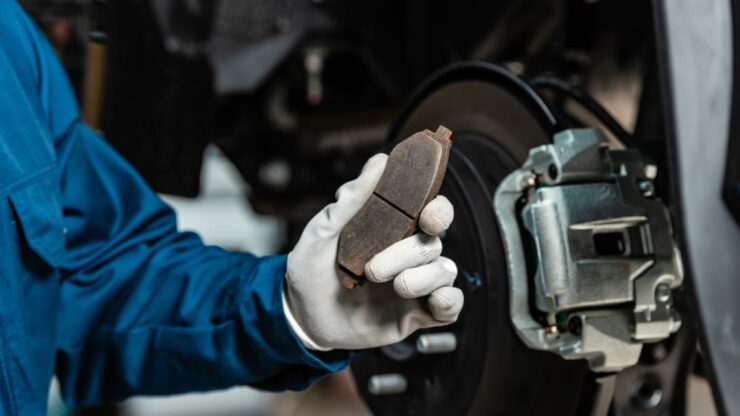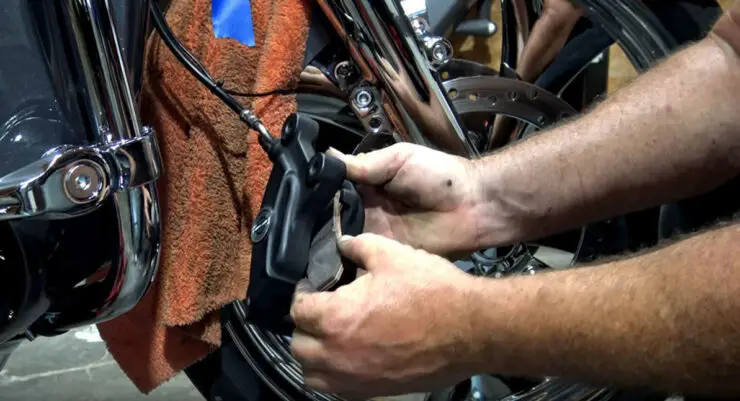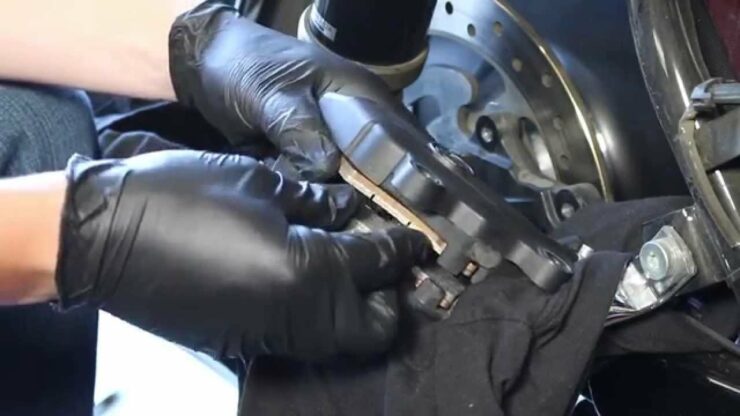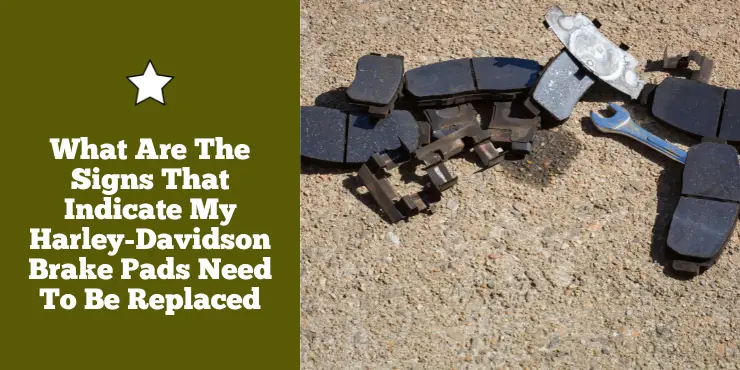If you’re a proud owner of a Harley-Davidson motorcycle, you know that riding a beast like that comes with a unique sense of thrill and adventure. However, to ensure a safe and enjoyable ride, it’s essential to be aware of when certain components need attention. One critical aspect of your Harley-Davidson’s performance is its brake system, and specifically, the brake pads. These small yet mighty components play a crucial role in stopping your bike effectively. So, how can you tell if it’s time to replace your Harley-Davidson brake pads? In this article, we’ll explore the key signs to look out for that indicate when your brake pads are wearing thin. Buckle up and let’s dive in!
Importance of regular brake pad inspection in Harley-Davidson bikes
Harley-Davidson bikes are celebrated for their iconic design and powerful engines but what goes unnoticed is the critical role played by the braking system in ensuring both safety and a smooth ride. Among the different components of the braking system, brake pads will be the lynchpin. Regular inspection of these pads will be important for preserving your own safety, enhancing your riding experience, and extending the lifespan of your Harley-Davidson motorcycle. Here is the importance of regular brake pad inspection in Harley-Davidson bikes –
>>> Click here to read our review of the Best Break Pads For Harley-Davidson <<<
#1. Safety on the road
Safety is the paramount reason for making regular brake pad inspection a priority. In any motorcycle, and especially Harley-Davidson bikes, stopping quickly and efficiently will be important to avoid accidents, collisions, and injury. Brake pads are responsible for creating the friction needed to convert your motorcycle’s kinetic energy into heat energy, slowing it down, and ultimately bringing it to a halt. Ensuring that the brake pads are in optimal condition as it’ll be the first line of defense against potential accidents.
#2. Timely detection of wear
Over time, brake pads naturally wear down due to the friction generated during braking. This wear is inevitable but regular inspections will allow you to detect it before it becomes a safety concern. By examining the brake pads at predetermined intervals, you’ll be able to identify signs of wear, thinning, or damage, and address these issues before they compromise your motorcycle’s braking performance.
#3. Consistent braking performance
Consistency will be key when it comes to braking performance. Whether you are cruising on a scenic route or navigating city traffic, you’ll want your brakes to respond predictably and smoothly. Regular brake pad inspections help maintain the consistent performance that Harley-Davidson riders rely on, ensuring that your motorcycle stops reliably each time you squeeze the brake lever.
#4. Prevention of brake fade
Brake fade is a phenomenon where prolonged or aggressive braking causes a reduction in braking efficiency due to excessive heat buildup. This can result in a soft brake pedal or lever, increased stopping distances, or complete brake failure in extreme cases. Regular brake pad inspections will help prevent brake pads by ensuring your pads aren’t excessively worn and that the braking pad is operating optimally.
#5. Cost savings
Ignoring brake pad maintenance can result in costly repairs down the road. When the brake pads wear down beyond their safe limit, they could damage the brake rotors, which are more expensive components to replace. By conducting regular inspections and replacing brake pads as needed, you’ll be able to prevent these costly repairs and extend the lifespan of your entire braking system.
#6. Peace of mind
Riding a Harley-Davidson bike should be an exhilarating experience filled with the freedom of the open road. Regular brake pad inspections offer peace of mind, knowing that your brakes are in great condition. This confidence will allow you to focus on enjoying your ride without the nagging worry of compromised safety.

What are the signs that indicate my Harley-Davidson brake pads need to be replaced?
Riding a Harley-Davidson bike is an exhilarating experience but it is also important to prioritize safety. One of the most important aspects of motorcycle safety will be ensuring your braking system is in top-notch condition. Brake pads play a key role in the braking system. However, recognizing the warning signs that indicate your bike’s brake pads need replacement will be important for both your safety and the performance of your bike. This is why you might be wondering what are the signs that indicate my Harley-Davidson brake pads need to be replaced. Here are some of the signs that indicate the brake pads in your Harley-Davidson bike must be replaced –
Squeaking or squealing noises
One of the noticeable and prevalent signs that your Harley-Davidson bike’s brake pads need replacement will be the presence of high-pitched squeaking or squealing noises when you apply the brakes. These noises are caused by a built-in wear indicator on the brake pads themselves.
Brake pads come equipped with wear indicators, which are metal tabs or grooves that come into contact with the brake rotors when the pads wear down to a certain level. This contact creates a squeaking or squealing noise during braking, acting as the audible warning that it is time for brake pad replacement.
When you’re hearing these noises, it’ll be a clear signal that your brake pads have worn down significantly and it is time to have them replaced. Ignoring these warning sounds can result in further damage to the brake pads and a compromised ability to stop your bike
Grinding or growling sounds
If you hear grinding or growling noises when you apply the brakes on your Harley-Davidson bike, it’ll be a more severe warning sign that demands immediate attention. These noises suggest that the brake pads are worn down to the metal and that the metal backing of the pad is coming in direct contact with the brake rotor. This metal-on-metal contact creates the grinding or growling sounds that you hear during braking.
Grinding or growling noises are a strong indication that your motorcycle pads are critically worn and need urgent replacement. Continuing to ride with severely worn pads can result in extensive damage to the brake rotors, which could be costly to repair or replace.
Reduced braking ability
Reduced braking ability is one of the most dangerous and noticeable signs that your Harley-Davidson bike’s brake pads are in dire need of replacement. When your bike doesn’t stop as effectively or as quickly as it once used to, it’ll be a clear indication that the brake pads have worn down to a point they can no longer generate sufficient friction to stop the bike safety.
Reduced braking ability can result in longer stopping distances and decreased control over your bike, especially in emergency braking situations or when navigating challenging road conditions. When you experience reduced braking ability, it isn’t just a sign that the brake pads need replacement, it is a matter of safety. Failing to address this issue promptly could result in significant risks to your safety and the safety of others on the road.
Brake system warning light
Many modern Harley-Davidson motorcycles come equipped with a brake system warning light on the dashboard. This light is designed to alert you to potential issues with the braking system, including brake pad wear. When the warning light illuminates, it will be important to take immediate action.
The brake system warning light is usually connected to a sensor that monitors the thickness of the brake pads. When the pads wear down beyond a certain point, the sensor triggers the warning light.
The activation of the brake system warning light will indicate that the brake pads have reached a critical level of wear and need prompt replacement. Failing to address this warning can result in compromised braking performance.
Vibration or pulsation when braking
If you experience vibrations or pulsations in the handlebars or brake lever when you apply the brakes on your Harley-Davidson bike, it’ll be another significant sign that your brake pads need attention. These sensations can be disconcerting and could affect your ability to control the motorcycle effectively.
Vibrations or pulsations during braking tend to be the result of uneven wear or the development of grooves on the brake pads and brake rotors. This uneven surface creates an inconsistent contact point between the brake pads and the rotors, leading to vibrations.
Vibrations or pulsations during braking will not only compromise your control over the motorcycle but also indicate that the brake pads are no longer making consistent contact with the rotor. This symptom should not be ignored as it can result in further damage to both the pads and the rotors.

Increased stopping distance
Another noticeable and concerning sign that your Harley-Davidson bike’s brake pads require replacement is an increased stopping distance. This means when you are applying the brakes, it takes longer for your bike to come to a complete stop than it used to. This sign can be especially alarming, especially when riding in heavy traffic or encountering sudden obstacles on the road.
As brake pads tend to wear down over time, the thickness of the friction material decreases. When the pads become too thin, there will be less material available to create the necessary friction against the brake rotor, resulting in longer stopping distances.
An increased stopping distance will be a clear indication that the brake pads have worn significantly and can no longer offer the necessary stopping power. Ignoring this sign can jeopardize your safety and the safety of other riders on the road.
Visible pad wear
One of the most apparent signs that your Harley-Davidson bike’s brake pads need replacement will be visible pad wear. Brake pads are designed with a specific thickness of friction material and when the material wears down to a certain point, it’ll be time for replacement.
You can visually inspect the brake pads through the caliper or by removing the wheel. Look for the thickness of the friction material on the pad. New brake pads will come with a substantial amount of material while worn pads have a thinner surface.
When you visibly notice that the brake pad material is significantly worn down, it’ll be a clear indication that it is time for replacement. Continuing to ride on worn brake pads can end up compromising your safety and lead to reduced braking performance.
Uneven pad wear
Uneven pad wear will be another visual sign that point to issues with your bike’s brake pads. When brake pads wear unevenly, it could indicate problems with the braking system that need addressing.
Examine the brake pads for signs of uneven wear. This could include one pad having significantly less material than the other or the brake pad wearing unevenly across its surface.
Uneven pad wear could be a result of various factors, including issues with the caliper, brake fluid, or rotor. When you notice uneven wear, it will be important to investigate and address the underlying problem. Replacing the pads alone might not resolve this issue.
How to inspect brake pads in Harley-Davidson bikes?
Your Harley-Davidson bike is basically your ticket to freedom on the open road and ensuring that it remains safe and reliable will be important. Your bike’s braking system, including the brake pads, is a crucial aspect of your and your bike’s safety. Regular brake pad inspections are important for your safety and the longevity of your motorcycle. Here are the steps you need to follow to inspect the brake pads in your Harley-Davidson bike –
Step 1: Gather the necessary tools
Before you can start inspecting your Harley-Davidson bike’s brake pads, you must gather the necessary tools and equipment. Here are some of the tools you will require –
- A set of wrenches or socket wrenches
- A flashlight or a well-lit area
- A mirror or inspection camera
- A measuring tool
Step 2: Locate and access the brake pad components
Accessing the brake pad components on your Harley-Davidson bike might require some disassembly depending on your bike’s model and design. Here are the steps you will need to follow –
- Park your bike on a stable and level surface
- Make sure that your motorcycle is turned off and the ignition is in the “OFF” position
- For front brake pads, you need to locate the brake caliper on each side of the front wheel as they’re typically positioned over the brake rotor
- For rear brake pads, you can locate the brake caliper near the rear wheel
Step 3: Assess pad thickness and wear indicators
Once you have accessed the brake pad components, you can start assessing their condition. Make use of a flashlight or inspection light to get a clearer view of the brake pads. Measure the thickness of the brake pad material using a vernier caliper or a brake pad thickness gauge if available.
Compare the measured thickness according to the manufacturer’s recommended minimum thickness specified in your bike’s owner’s manual. If the pad thickness is at or near the minimum, it will be time for replacement.
Moreover, many brake pads come equipped with wear indicators. They are typically small grooves or notches on the pad surface. If the pad material has worn down to the level of these indicators, it’ll be a clear sign that replacement will be needed.
Step 4: Check for uneven wear across front and rear brakes
It is important that you ensure that both front and rear brake pads wear evenly for consistent and balanced braking performance. You must inspect both the front and rear brake pads individually.
You must compare the thickness and wear indicators on both sides of the wheel. The brake pads on each side must wear at a similar rate. If you’re noticing a significant difference in wear between the left and right sides, it might indicate a problem with the brake caliper, rotor, or other components that require further investigation.
Factors that contribute to brake pad wear in Harley-Davidson bikes
Harley-Davidson bikes are highly revered for its power and performance but a safe and enjoyable riding experience will depend on the performance of your bike’s braking system. Among the vital components of this system, brake pads play a key role. Understanding different factors that contribute to brake pad wear in your Harley-Davidson bike is essential for both safety and maintenance. Here are some of the key factors that contribute to brake pad wear on your Harley-Davidson bike –
#1. Riding style
One of the most significant factors that influence brake pad wear will be your riding style. Aggressive riding, characterized by frequent and heavy braking will generate more heat and friction on the brake pads. This increased demand for stopping power can result in accelerated wear and tear on the pads.
To extend the lifespan of the brake pads, you must practice smooth and progressive braking techniques. Carry out engine braking whenever possible by downshifting and anticipate stops to reduce the need for abrupt braking.
#2. Riding conditions
The road conditions you’re encountering can greatly impact the brake pad wear. Riding in heavy traffic, on hilly terrain, or through areas having frequent stop-start traffic can increase the stress on the brakes and accelerate pad wear. In challenging riding conditions, you must maintain a safe following distance from vehicles ahead to reduce the need for sudden and aggressive braking.

#3. Load and passenger
Carrying a passenger or additional cargo on your Harley-Davidson bike will increase the overall weight of the bike. The added load places additional strain on the braking system, as it should work harder to bring the motorcycle to a stop. Be mindful of your motorcycle’s weight limits and adhere to the manufacturer’s recommended load capacity to reduce excessive wear on the brake pads.
#4. Environmental factors
Environmental conditions can also impact brake pad wear. Riding in wet or muddy conditions can cause abrasive contaminants to stick to the brake pads and rotors, accelerating wear. Moreover, exposure to extreme temperatures can affect the performance and longevity of brake pads. When possible, you should avoid riding through standard water or mud, and consider inspection of brake pads and periodic cleaning if you regularly ride in adverse conditions.
#5. Quality of brake pads
The quality of the brake pads you can use will significantly affect their lifespan. High-quality OEM brake pads are designed specifically for your Harley-Davidson bike’s model and are engineered for optimal performance and durability. Inferior or aftermarket brake pads might wear out more quickly.
When it is time for replacement, you must consider using genuine Harley-Davidson brake pads or trusted aftermarket options recommended by experienced riders or technicians.
#6. Lack of maintenance
Regular maintenance plays key role in extending the lifespan of the brake pads on your Harley-Davidson bike. However, if you do not maintain them properly, they can end up wearing out quicker. Routine inspections, cleaning, and lubrication of brake components will help reduce friction and wear on the brake pads. You must include rake pad inspections in your regular maintenance schedule and address any issues promptly to prevent further wear and damage.
FAQs
How can I tell if my Harley-Davidson brake pads are worn out and need to be replaced?
You can check for signs of wear by examining the thickness of the brake pads. If they are less than 3 millimeters thick, they should be replaced.
Another indication is if you hear squeaking or grinding noises when applying the brakes. This could be a sign that the brake pads are worn down and the metal backing is starting to rub against the rotor.
You might also notice a decrease in braking performance, such as longer stopping distances or a soft brake pedal. If you experience any of these issues, it’s a good idea to have your brake pads checked.
What are the typical lifespan and mileage for Harley-Davidson brake pads?
The lifespan of Harley-Davidson brake pads can vary depending on various factors such as riding style, terrain, and maintenance. However, a rough estimate is around 20,000 to 30,000 miles.
Keep in mind that this is just an average, and some riders may need to replace their brake pads sooner while others may get more mileage out of them.
Regular inspection and maintenance are essential to ensure optimal performance and safety. If you notice any signs of wear or decreased braking performance, it’s best to replace the brake pads as soon as possible.
Can I visually inspect my Harley-Davidson brake pads to determine if they need replacement?
Yes, you can visually inspect your Harley-Davidson brake pads to get an idea of their condition. Remove the wheel to gain access to the brake caliper and pads.
Check the thickness of the brake pads. If they appear to be significantly thinner than when new (around 3 millimeters), it’s time for replacement.
Take note of any cracks, uneven wear, or shiny spots on the brake pad surface. These signs indicate that the brake pads have reached the end of their lifespan and should be replaced.
However, it’s important to remember that a visual inspection should be accompanied by other signs like unusual noises or decreased braking performance to determine if replacement is necessary.
>>> Read more about Break Pads For Harley-Davidson <<<


